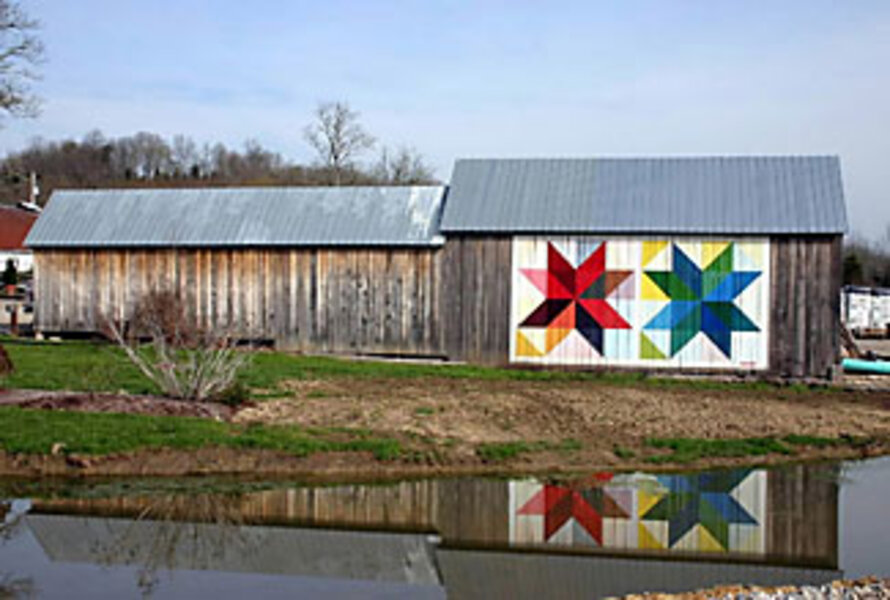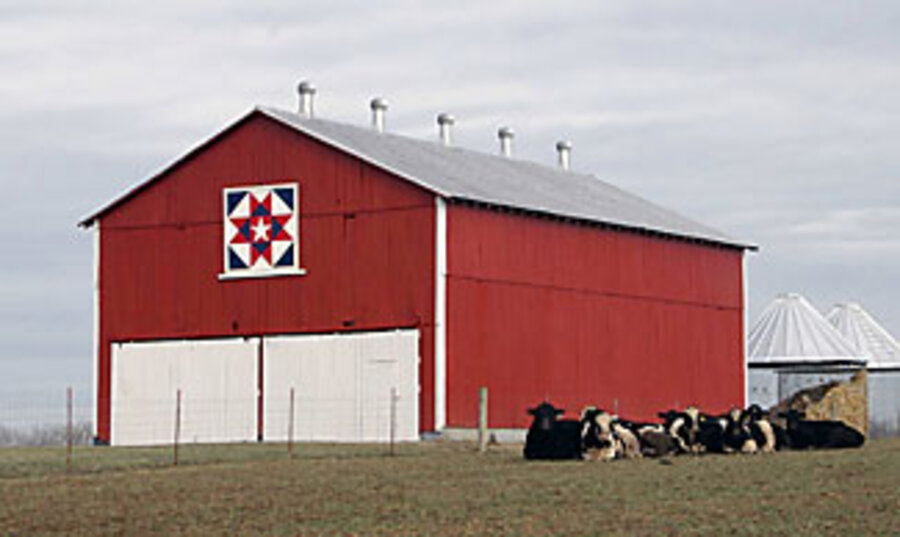Follow the quilt barn trails
Loading...
There was never a grand plan for the single quilt square that Donna Sue Groves envisioned painting on the family barn in Adams County, Ohio, in 2001. It was just meant to be a gesture honoring her mother, Nina Maxine Groves, her rural heritage, and the five generations of her family that have shared a love of quilting.
Ms. Groves never imagined her idea would lead to colorful quilt patterns with names such as friendship star, bow tie, and brown goose appearing on more than 2,000 barns in 22 states. Most are located along what are now called quilt barn trails, which give nature lovers another reason to explore the countryside.
The "barn quilting bee" began when friends gathered to plan painting the elder Mrs. Groves's snail's-trail quilt pattern on the barn. Conversation led to the suggestion of a "trail of quilt barns" that people in Adams County might enjoy. Groves's mother mentioned that 20 squares are on an average quilt, and that number became the target.
The informal group asked Mrs. Groves to select the different quilt squares, and then they set off to find willing barn owners. As the 20 Adams County quilt squares began to appear, photos and conversation about the project spread to other counties in Ohio, then into other states.
Similar quilt barn trail initiatives blossomed as quickly as a quilter buys fabric. Today Ohio, Iowa, and Kentucky each have more than 250, and the grass-roots art project continues to spread.
There are several reasons for the popularity of quilt-square barns. Volunteers see them as an opportunity to contribute to the community in a fun and visible way. Farmers see them as a way to get people into the countryside, share their love of the land, and honor someone in their family.
But the underlying belief is that combining a barn with a quilt pattern honors quilting and farming, two important aspects of American life since colonial times.
Quilt trails also bring an economic benefit to communities by attracting tourists to rural areas.
Brandy Boggs, the Vinton County, Tenn., marketing director leading a 20-quilt barn initiative, says that until recently her county was known for covered bridges and outdoor sporting activities. "Now, despite no advertising, we get calls all the time wanting to know if we have any quilt barns," she says.
A typical county quilt barn trail committee selects a route so a new quilt square becomes visible every five or 10 miles. Often it works out to be one per township, so many times willing farmers are bypassed. Now, however, some farmers are hiring artists to paint their barn squares and are paying for the work themselves.
"There are no 'quilt barn police,' " Groves says. "People can do what they want if they are not on an official quilt barn trail."
The selection process for the pattern used on a barn varies by county. Some squares represent quilts that have been in the family of the barn owners for generations. Squares on the Athens County trail have historical ties to the area.
For example, a colorful star brick block recalls the turn of the century when brickmaking was an important area industry.
Some areas have used local artists. In Vinton County, one square was painted at a local festival where anyone could add a few brush strokes. Others were done by senior citizens, Boy Scouts, and 4-H members who raised the money to fund the project.
JoAnn May is a professional artist who was hired to paint 20 squares on barns in Brown County, Ohio. "This is a wonderful way to bring public art into a rural community and make it accessible," she says, adding, "From my perspective it ties art to a craft women have always done."
Funds to pay for having a quilt square painted on a barn come from a variety of sources. Community art grants, public and business donations, and fundraising events have all been used to cover expenses, which range from $300 to $500 per barn.
Even though barns are selected partly based on the overall appearance of the farm, Ms. May says that farmers begin to tidy up well before she starts working on their square: "There is a sense of excitement and anticipation." Family reunions and picnics frequently follow once the square is completed.
As the number of barn trails continues to increase, Groves is busy traveling to counties around the country offering free advice and support. The only thing Groves asks is that the barn owners understand that the original idea was to honor her mother and that they do the same for the women in their family.






